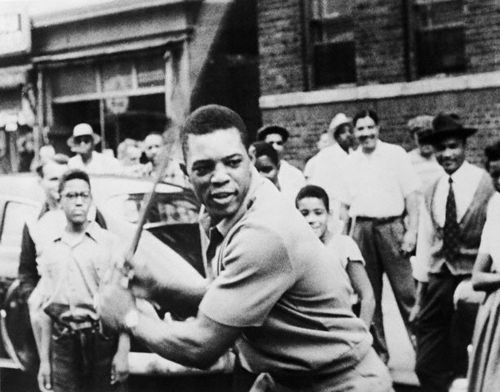Great Reads
Remembering… STICKBALL!
April 16, 2020

The great Willie Mays playing a game of stickball in NYC.
Last month, the millions of sports fans who come together each year to participate in America’s favorite pastime, as the 2020 Major League Baseball season was set to begin, were left without their annual tradition of Opening Day. Where this day traditionally signals the perfect opportunity to cram into a stadium with thousands of fellow fans, this year requires Americans to do the exact opposite and practice extreme social distancing to stop the spread of the coronavirus crisis. Many families took to the streets (or their backyards) to celebrate the day with their own, dressed down versions of baseball. This brings to mind the long-held (but often forgotten) tradition of Stickball.
These days when we think of stickball (and I bet you not many people do), we tend to think of it as an extinct game that has more in common with the dinosaurs on display in the Museum of Natural History than it does with the sport of baseball. Yet, there was a time – and not too long ago, mind you – when stickball roamed the earth. More specifically, there was a time when witnessing a game of stickball in a neighborhood such as the Lower East Side was as common as witnessing a game of pickup basketball today. It was ubiquitous and popular. So where did stickball come from? And what exactly happened? And finally, is there any chance it could come back? Or is it doomed to end up in the Human Memory Dump and tragically fade away into oblivion like Bing Bong from Inside Out?
First, what exactly is stickball? Well, simply put, it is a street game –usually formed as a pick-up game- that follows the rules of baseball despite using different forms of equipment. Typically, a broom handle is used for a bat and a rubber ball, often a Pinky ball replaces the traditional baseball. One of the cool elements of stickball is the adjustment made to the rules of baseball to fit the street location of where the game is being played. A manhole cover may be used as a base (or home plate) and buildings for foul ball lines. A square rectangle representing the strike zone would often be drawn in chalk on a building wall to provide a target for the pitcher. The batter is out when the ball is hit and caught on a fly or if the ball is hit on the ground and caught on a single bounce. If the ball hits a roof, porch, or breaks a window from afar, it is often ruled a home run. Rules and variations change depending on the location, but often the game involves the hitter running to a base (though there are variations where there is no running).
From the description of stickball, you can understand why it would have been a popular game in New York City and especially the Lower East Side (though make no mistake, it was popular across the country, especially in cities like Boston and Philadelphia). It lent itself perfectly to the neighborhood layout, and it was a cheap game to play. Balls only cost a few cents, and most homes had a broom stick that could be converted to a bat. Stickball’s rise in popularity – which peaked in the 1950’s and 1960’s – was also a reflection of what was available to kids during that time period. In the pre-Internet, pre-video game, pre-Cable world of 1950’s and 60’s New York, a cheap game like stickball had an immediate appeal. It was easily accessible, and a way to be with your friends and stay outdoors. It also helped stickball’s popularity that the iconic centerfielder for the then New York Giants (and arguably one of the most popular athletes in the United States at the time), Willie Mays, would often be seen playing the game outside his New York apartment with the local kids. While New York is still a baseball-crazed town, during the 1950’s when the city had three Major League teams (Yankees, Dodgers, and Giants), baseball was easily the most popular sport in town.
Stickball remained a common and frequent sight in various areas of the city up until the 1980’s (here is a video of actor Khalil Kain visiting his childhood neighborhood in New York and describing his memories of playing stickball). But popularity in the game dropped dramatically come the late 1980’s as youths had alternatives to turn to, including video games, cable television, and skate boarding, among other things. Also, while Major League Baseball was – and remains – popular, interest among youths in the NBA and NFL skyrocketed. By the 1990’s, you would have had a better chance of finding a three-legged ballerina than a pickup stickball game in New York City.
However, this blog does not end with the death of stickball. Stickball does, in fact, still exist in New York City in a certain capacity. The New York Emperors Stickball League, formed in the Bronx in 1985, is an eight team adult stickball league (though they do have a youth division) that plays 180 to 240 games a year! It even hosts an annual tournament every Memorial Day weekend that attracts teams from California, Florida, and Puerto Rico. So who knows, perhaps there is some hope out there for the long term future of stickball? In that case, stickball enthusiasts and supporters would agree with the late, great Mets reliever Tug McGraw’s saying: Ya Gotta Believe!
Want more? Listen to our podcast season 2 opener ‘Our Game’ where host Amanda Adler-Brennen talks with baseball historians and stickball players about the significance for city kids in being able to turn city streets and the sides of buildings into their very own ‘field of dreams’.
- Updated by Jamie Salen, 2020.
- Original post by Jonathan Pace, 2016